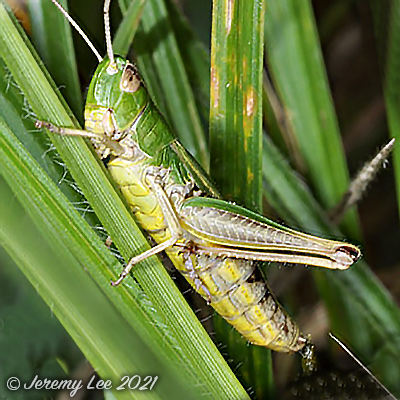
 |
|
Scientific Classifications explained » Amphibians » Ants » Aphids » Bees » Beetles » Birds » Bugs » Butterflies » Caterpillars » Damselflies » Dragonflies » Earwigs » Flies » Frog/Leafhoppers » Fungi » Galls » Grasshoppers » Harvestmen » Hoverflies » Lacewings » Ladybirds » Leaf Mines » Lichens » Mammals » Millipedes » Mosses » Moths » Sawflies » Slugs » Snails » Spiders » Trees & Shrubs » Wasps » Wild Flowers » Woodlice » Postboxes |
UK Nature > Grasshoppers > Chorthippus parallelus

Scientific Name: Chorthippus parallelus Common Name: Meadow Grasshopper Chorthippus parallelus is typically predominantly green. There is often a dark grey/brown stripe running through the eye and the flanks of the abdomen are usually more or less mottled black or with distinct black bars. The hind femur is typically plain pale brown or greenish above with a herringbone pattern extending down the middle. Like the Field Grasshopper, some rather bizarre colour variations occur in this species; purple specimens are not that uncommon. At maturity, the females wings barely extend halfway down the abdomen. Mature males have longer wings that almost extend to the tip of the abdomen which, at maturity, is brownish. Its life cycle is very similar to that of the Common Field Grasshopper (Chorthippus brunneus) although the emergence of the nymphs and adult maturity occur slightly earlier. Very common and found in all but the driest grassland sites. Nymphs from late April to June, adults from June until mid November. |
|

https://www.uknature.co.uk is a website dedicated to showing the immense diversity of UK nature and wildlife. Our vast range of habitats, from lowland arable to snow covered mountains, from storm-ravaged coastlines to peaceful inland freshwater lakes and rivers, from dry, sandy heaths to deciduous and coniferous forests, all these habitats contribute to the abundance of UK nature. We have wild birds in huge numbers either residing or visiting our shores (597 recorded species as at July 2013) and we must also not forget the humble back garden with its grass lawns, flower beds filled with nectar rich flowers, shrubs and trees, all designed to attract huge numbers of insects such as bees, moths, butterflies and hoverflies; and finally the small ponds which provide safe havens for frogs, toads, newts and even slow worms and grass snakes. www.uknature.co.uk is the showcase for my personal passion, photographing uknature in all its glory. I sincerely hope you all enjoy the fruits of my labours. This site and all images contained therein is © Jeremy Lee 2004 - 2025. All Rights Reserved. Site design by Jeremy Lee. Site development & IT Support by Stuart Lee. |